June 30, 2024 – Firearm companies, like most companies, construct unique product synergism to attract customers.
In 1864, the Brooklyn, Bath and Coney Island Railroad extended its service to Coney Island, and to the area’s handful of small beach resort hotels, and began investing heavily in Coney Island’s development.
By 1884, the area’s beaches, resort hotels and amusement attractions were drawing 25,000 – 30,000 visitors each weekend. Before Coney Island, the trains ran full during the week, moving commuters to and from work, but they were idle on the weekends. With the draw of Coney Island, trains were operating at capacity seven days a week. Product mutualism.
Sometimes it is difficult to tell if firearm manufacturers, or ammunition manufacturers, are the Coney Island or the railroad, with each product defined as optimal, only when complimented by the presence of the other. Both products are often marketed as “New” and “Different”, with a little “Improved” sneaking into the mix.
As a practical matter, the differences between generations and brands of firearms is nuance. Changes are evolutionary, often aesthetic in nature, and intended to create the illusion of a breakthrough “New” and “Different” presence.
Most tangible changes are actually made to facilitate cost reduction, assure compliance with ever changing government mandates, or as a defense against the onslaught of anti gun product liability suits. Improved performance, however, is often a secondary result of meeting those primary objectives.
Changing from complicated and costly mating of a steel barreled action to a precisely inletted walnut stock, to a composite stock with a rigid, minimal contact barreled action mounting system, saves vast amounts of labor and material cost. Fortunately, the change also makes it easy to produce a consistently accurate firearm.
Does a cartridge sell firearms, or firearms sell cartridges
The Winchester Model 70 Featherweight is not synonymous with the 6.8 Western cartridge. The 6.8 Western is only one of the fifteen standard and magnum cartridges offered with this firearm.
No, I am not discounting the 6.8 Western cartridge. I am just saying that each chamber denotes an application, and each applications is only a fraction of the firearm’s potential. This particular Winchester model can be selected in chambers appropriate for anything from varmint hunting, up through big and dangerous North American game.
The Featherweight – 6.8 Western combination was selected for review, because it offered an opportunity to satisfy a technical curiosity, to develop and publish handload data for the cartridge, and to evaluate its ballistic output and accuracy.
In a perfect world, only 270s would be permitted… Albert Einstein
Pictured above L-R: The 270 Winchester has been a factory hot rod since its release in 1925, and a Winchester original. While it has an excellent reputation as a hunting rifle, it never had a reputation for competitive target shooting accuracy.
The 6.8 Western is a Creedmoored version of the 270 WSM; increased OAL, shortened case, set back shoulders, and six grains less capacity. These changes were made to facilitate the use of heavy for bore, VLD profile bullets in a shortish action, with less impingement on powder capacity.
The 270 WSM is one of the WSMs that quickly obsoleted my favorite jumbo cartridge line, the Remington Ultra Magnums. I tried all of the WSMs in search of redeeming qualities, and the 270 WSM proved to be quite… nifty.
The 270 Weatherby marks the first commercial Weatherby cartridge. Designed in 1943, brought to market in 1945, it reminds me of when Weatherby firearms and cartridges still reflected Roy Weatherby’s style and legacy.
What exactly happened in 2021…
Well, it is said that the 6.8 Western was a collaboration between the companies Browning and Winchester. I am assuming that is the FN owned Browning firearms company and the Olin owned Winchester ammunition brand. If it were the Browning firearms company, and the Winchester firearms company, they are both owned by FN, which would have made it the development more of an internal company conversation. Sheriff Bart, Blazing Saddles.
At the 6.8 Western’s introduction, Winchester chambered nine Model 70s and fourteen XPRs for the cartridge, and Browning added twenty one X-Bolt Models to that count. Wow! Forty four rifles chambered for the then new cartridge.
Currently, Winchester offers twenty eight models and configurations for the 6.8 Western, and Browning offers thirty four, for an aggregate of sixty two models and configurations. Joining Browning and Winchester firearms in chambering for the 6.8 Western are Seekins Precision, Fierce Firearms, Christensen Arms. Certainly smells like success. But listing a chamber and getting press, are a bit different than building, shipping and selling rifles in that chamber.
After three years in production, with all of those firearms listed, and lots and lots… and lots of publicity, there are only eight factory loads listed. Of the eight, three are generally available, two of those not yet released in production. All are labeled Winchester and Browning, which means all are produced by Olin. Five were generally available when the cartridge was introduced. Not a great trend.
By comparison, there are sixty six loads for the 270 Winchester, nineteen loads for the 270 WSM and six active loads for the 270 Weatherby. Yes, these are all more established than the 6.8 Western, some in production since the early 20th century but, for all of the supporting firearms and marketing, I don’t see the 6.8 Western growing legs.
I cannot tell if the limited ammunition company participation is to force the sale through one company, Olin, or if it is a lack of broader interest from competitors. It would seem that Federal, as an example, could participate along with Winchester, as Olin holds an ownership stake in Federal.
Why?
Outside of a lab that can split ballistic hairs, and the marketing departments looking for anything to draw attention to their respective products, there is little justification for a 0.277″ cartridge, let alone the 6.8 Western.
The 0.277″ bullet typical weight range does not have high sectional density, they don’t have, when compared to other calibers, particularly good ballistic coefficients, they don’t show well in competitive shooting, and they are too big for small game, while marginal for big and dangerous game.
Even if 0.277″ crazed fans insisted on having access to the caliber, with at least three 0.277″ cartridges having service that caliber for as long as one hundred years, what does the addition of the 6.8 Western accomplish? Coney Island… without the Cyclone.
Twenty five grain increased bullet weight and a short action? Maybe not…
Again, the promotional material for the 6.8 Western suggests it is a 270 WSM derivative, only the cartridge has been dimensionally optimized to permit the use of heavy for bore bullets in a short action firearm, while surrendering a minimal amount of powder capacity. A couple of thoughts…
When is a short action, not a short action? When it is an intermediate length action… which is what Winchester uses for the 6.8 Western. The bolt stroke for a Model 70 short controlled feed action is 4.030″, as measured. The bolt stroke for the Model 70 Featherweight 6.8 Western is 4.250″, as measured.
In terms of case powder capacity, the 6.8 Winchester holds less powder. The 6.8 Western has 67.8 grains H2O capacity, the 270 WSM has 71.2 grain H2O capacity. Which may, or may not be anything more than an academic difference.
What Winchester did most, to optimize the rifle for the newer, heavy 0.277″ bullets, was to tighten the rate of twist. The 6.8 Western gets an 8″ twist, while the 270 Winchester and 270 WSM rifle versions get a 10″ twist. To offset the slight loss of powder capacity, operating pressure has been increased to 65 KPSI, over the 270 WSM’s 63.8 KPSI.
So 0.277″ bullet, 175 grains top weight, high sectional density and ballistic coefficient. Seems like the makings for a long range cartridge for competitive shooting events. However, there is only one factory heavy bullet load with a match bullet, the rest are expanding type bullets suitable for hunting.
Performance
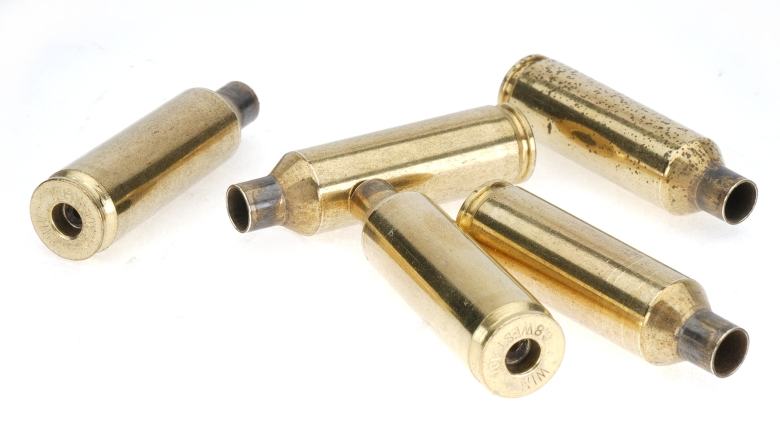
 I did not have a variety of factory ammunition to select from, but I did manage to get some Winchester Copper Impact 6.8 Western Ammo 162 Grain Polymer Tip Lead Free, at $67/box. By comparison, a full set of reloading dies cost $42.
I did not have a variety of factory ammunition to select from, but I did manage to get some Winchester Copper Impact 6.8 Western Ammo 162 Grain Polymer Tip Lead Free, at $67/box. By comparison, a full set of reloading dies cost $42.
Without availability of component brass, all handloads were made from once fired factory brass. Winchester Copper has a muzzle velocity rating of 2875 fps. With the rifle locked down to a shooting bench, and chronograph ten feet from the rifle’s muzzle, the first 5 rounds MV averaged 2938 fps, with a min-max variation of 37 fps. The 100 yard group size was 0.6″.
The 0.277″ caliber cartridges, like a good number of other traditional cartridges, have been drifting upward in factory produced bullet weights. Additionally, bullet length has increased due to this additional weight, VLD designs and low sectional density all copper bullets. With weight increases have come decreased in muzzle velocity.
Bullets of greater length and lower velocity require a tighter twist to maintain stabilizing spin rates. The 8″ twist in the Winchester Featherweight clearly contributed to the rifle’s 6.8 Western accuracy.
I wish Winchester would make both the 270 Winchester and 270 WSM also 8″ twist calibers, as it would enhance their accuracy as bullet weight continues to shift upward. The tight twist concern was that over rotating a bullet would amplify bullet material and design imperfections.
At these velocities, and with the current high quality of bullets being manufactured, I doubt that would be a concern, and this was demonstrated with lighter bullet weight handloads.
What happens to the 6.8 Western with light bullets?
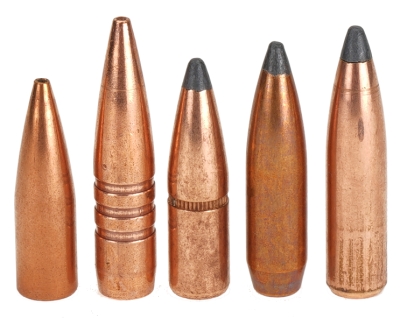
While the heavyweight bullet aspect of the 6.8 Western has appeal, most people do not buy individual rifles for each cartridge bullet weight offered, so checking performance with mid and lighter weight bullets seemed reasonable. L-R Hornady HP 110 grain, Barnes TSX 130 grain, Hornady SP 130 grain, Sierra GameKing 140 grain, Nosler Partition 150 grain.
COL was determined by bullet shank length, cannelure location or extended to cartridge maximum overall length as the rifle allowed. Only the 130 grain Hornady, located to its cannelure fell below minimum length spec, but presented no problems.
| Cartridge |
6.8 Western |
| Firearm | Winchester Model 70 |
| Barrel Length | 24″ |
| Min – Max Case Length | 2.020″ +0.0″/-0.020″ |
| Min – Max Cartridge Overall Length | 2.755″ – 2.955″ |
| Primer | CCI 250 LR Magnum |
| Bullet Diameter | 0.2780″ +0.0″/-0.003″ |
| Reloading Dies | Lee Precision FL |
| Bullet Type | Bullet Weight Grains |
Net H2O Grains Capacity |
COL” | Powder Type | Powder Charge Grains |
Muzzle Velocity fps |
Muzzle Energy ft/lbs |
100 YD 3 Shot Group” |
| Hornady HP | 110 | 69.6 | 2.760 | Alliant Reloder 17 | 64.0 | 3511 | 3012 | 0.9 |
| Hornady HP | 110 | 69.6 | 2.760 | Hodgdon Superformance | 66.5 | 3566 | 3107 | 0.6 |
| Hornady HP | 110 | 69.6 | 2.760 | IMR 4831 | 64.5 | 3453 | 2913 | 0.8 |
| Barnes TSX | 130 | 65.2 | 2.755 | AA MagPro | 68.0 | 3286 | 3118 | 0.8 |
| Barnes TSX | 130 | 65.2 | 2.755 | Hodgdon Superformance | 61.0 | 3213 | 2981 | 1.1 |
| Barnes TSX | 130 | 65.2 | 2.755 | Hodgdon Hybrid 100V | 59.0 | 3180 | 2920 | 0.8 |
| Hornady SP | 130 | 66.4 | 2.655 | AA MagPro | 69.0 | 3303 | 3150 | 0.9 |
| Hornady SP | 130 | 66.4 | 2.655 | Alliant Reloder 23 | 64.0 | 3226 | 3005 | 0.7 |
| Hornady SP | 130 | 66.4 | 2.655 | Hodgdon Hybrid 100V | 60.0 | 3198 | 2953 | 0.6 |
| Sierra GameKing | 140 | 68.1 | 2.900 | AA MagPro | 69.0 | 3237 | 3258 | 0.4 |
| Sierra GameKing | 140 | 68.1 | 2.900 | Hodgdon H4831 | 64.5 | 3155 | 3095 | 0.9 |
| Sierra GameKing | 140 | 68.1 | 2.900 | RS Magnum | 70.5 | 3200 | 3184 | 0.5 |
| Nosler Partition | 150 | 68.0 | 2.900 | AA MagPro | 68.0 | 3155 | 3316 | 0.8 |
| Nosler Partition | 150 | 68.0 | 2.900 | IMR 7828 SSC | 64.0 | 3113 | 3229 | 0.7 |
| Nosler Partition | 150 | 68.0 | 2.900 | RS Magnum | 70.0 | 3140 | 3285 | 1.1 |
Nothing special in assembly. Powder selections are very similar to the 270 WSM and 7mm Remington Magnum. 6.8 bullet prices are allover the place. Traditional weights, below 160 grains are quite reasonable in price with 130 grain to 150 grain bullet prices ranging from 17¢ to 28¢ per quality major brands. Unfortunately, above 160 grain weight falls into the 60¢ and above range.
Conclusions?

The Winchester Model 70 Featherweight offers all the tradition anyone could want in a modern factory rifle; excellent action, trigger, deeply blued and classic black walnut stock. The only real signs of “modern” are mostly hidden; more durable finishes, an updated trigger and improved barreled action bedding. It is a more much accurate Featherweight than even those produced even just five years ago. I do wish Winchester would put that 1:8″ twist in their other 0.277″ rifles.
The 6.8 Western? Tough one. If it originated before the 270 WSM it would be a standard. But it didn’t. I am not sure I can see a unique application that requires a 175 grain 0.277″ bullet, driven at moderate velocity, when a version of the 7mm Mag could easily do the same and more. Personally, I think the intermediate versus 30-06 length action is splitting hairs on a bald head.
For me, the 6.8 Western fits the mold of most cartridge introductions of the past twenty years. Not enough difference to make a difference to a hunter or competitive shooter, and too narrow in applications.


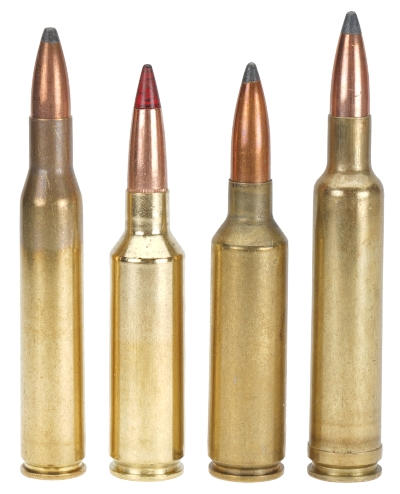
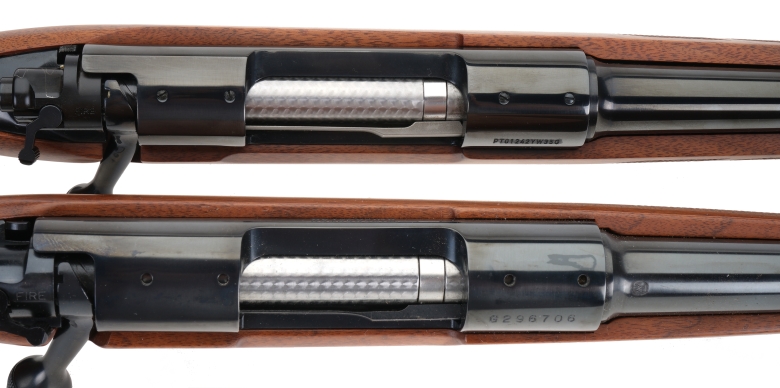
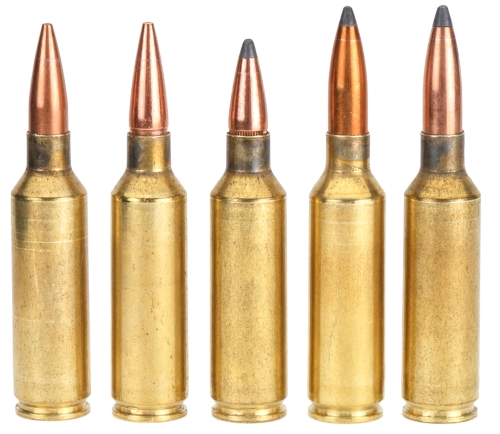
Email Notification